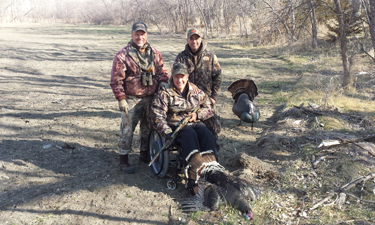 For a hunter, there’s nothing like getting out into the field, getting a prime target in your sights and taking a successful shot. Photos like the one above don’t happen easily — they take years of researching and carefully selecting firearms and gear, training with your weapon, finding a quality spot away from anything that might distract wildlife, setting up and waiting for hours for your quarry to come along (often in freezing temperatures), taking your shot, and praying that your aim was true and that you didn’t just scare away your quarry and waste all that effort.
For a hunter, there’s nothing like getting out into the field, getting a prime target in your sights and taking a successful shot. Photos like the one above don’t happen easily — they take years of researching and carefully selecting firearms and gear, training with your weapon, finding a quality spot away from anything that might distract wildlife, setting up and waiting for hours for your quarry to come along (often in freezing temperatures), taking your shot, and praying that your aim was true and that you didn’t just scare away your quarry and waste all that effort.
It’s an addicting passion, and one that millions of recreators across the country carry with them for life. However, injuries and disabilities often leave hunters feeling as if they aren’t able to continue with their sport. In South Dakota, the U.S. Army Corps of Engineers (USACE) and the State Department of Game Fish and Parks (SD GFP) have teamed up to get physically challenged hunters back in the field and pursuing a pastime they love.
The U.S. Army Corps of Engineers is well-known for the design, construction and operation of locks, dams and flood-containment systems around the world, but due to their management of public lands, they’re also involved in the realms of recreation and environmental protection. About 20 years ago, former USACE Natural Resources Specialist Michael Stanley conceived a program to support disabled hunters at the Oahe Downstream Recreation Area, which is located just north of the state capitol of Pierre. Although the area is generally limited against hunting, the infrastructure in place for the USACE worked well to help support accessible hunting blinds that could accommodate hunters with physical limitations. Over the years, USACE and SD GFP worked together to improve the program.
“The hunters used to be out in (hay) bale blinds,” says Russ Somsen, a natural resource specialist with USACE at Oahe. “We got a lot of donations from different agencies and built 10 accessible blinds. They’re semi-enclosed, and you can put a heater in them,” which can make a major difference for a mobility-limited hunter.
Each fall, up to 12 disabled hunters can participate in a two-day rifle deer season at the recreation area. This year, the program expanded to also include a turkey hunt in April. Stanley secured funding from the National Wild Turkey Federation to establish food plots for the area’s turkey population, and members of the organization volunteered to help with the hunt. Pat Buscher, Oahe Downstream Recreation Area district park supervisor, helps secure the tags and organize logistics for interested hunters. For the debut year of the turkey program, five South Dakotans drew tags in hopes of taking a male turkey.
Hunter Greg Brandner of Pierre harvested the first turkey of the year on April 18 at about 9:30 a.m. “He came running toward the blind when he heard the call,” Brandner says. “My adrenalin was flowing. He came within 20 yards of the blind.”
Somsen says he’s not sure how many tags SD GFP will issue for the turkey hunt in coming years, but he expects interest will increase as eligible hunters take notice. “It was the first year, so word wasn’t really out on it. It was the same way with our deer hunt. The first year, we only had maybe half the tags get filled, but after we had the hunt, the word got out that it was a pretty good program and everybody loved it, and now it’s always full. It’s got a lottery. It’s become pretty popular.”
Danielle Taylor is the Executive Editor of Parks & Recreation Magazine.

